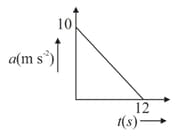Embibe Experts Solutions for Chapter: Kinematics, Exercise 1: Exercise 1
Embibe Experts Physics Solutions for Exercise - Embibe Experts Solutions for Chapter: Kinematics, Exercise 1: Exercise 1
Attempt the practice questions on Chapter 2: Kinematics, Exercise 1: Exercise 1 with hints and solutions to strengthen your understanding. Physics Crash Course BITSAT solutions are prepared by Experienced Embibe Experts.
Questions from Embibe Experts Solutions for Chapter: Kinematics, Exercise 1: Exercise 1 with Hints & Solutions
A car accelerates from rest at a constant rate for some time, after which it decelerates at a constant rate and comes to rest. If the total time elapsed is , then the maximum velocity acquired by the car is
A particle moving along x-axis has acceleration f , at time t , given by , where and T are constants. The particle at has zero velocity. In the time interval between and the instant when , the change in particle’s velocity is
A passenger in a train moving at an acceleration drops a stone from the window. A person, standing on the ground, by the sides of the rails, observes the ball falling
The initial position of an object at rest is given by . It moves with constant acceleration and reaches to the position after . What is its acceleration?
A particle starting from rest undergoes a rectilinear motion with acceleration a. The variation of a with time is shown below. The maximum velocity attained by the particle during its motion is

The displacement of a body is given by where is acceleration due to gravity. The velocity of the body at any time is
A ball is projected at an angle of above with the horizontal from the top of a tower and strikes the ground in at an angle of with the horizontal. Find the speed with which it was projected.
A car is moving on a circular road of radius and its speed is increasing at a rate At some instant its speed is net acceleration of the car at this instant is
